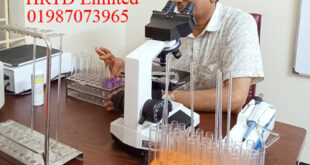
Hemoglobin Test
Hemoglobin Test. Hotline 01969947171. A hemoglobin test measures the amount of hemoglobin in your blood. Hemoglobin is a protein in red blood cells that carries oxygen throughout the body. The test is often done as part of a complete blood count (CBC) and can help diagnose conditions like anemia or monitor the effectiveness of treatments for blood disorders.
Hemoglobin Test are studied and Clinically Practiced in Pathology Courses. Pathology Courses are important for Diagnostic Tests. Pathology Course are Pathology Training Course 6 Months, Pathology Training Course 1 Year, Pathology Course 2 Years, Pathology Diploma Course 3 Years and Pathology Diploma Course 4 Years. All these courses are available in HRTD Medical Institute. HRTD Medical Institute is an Organization of HRTD Limited. HRTD Limited is a Govt Registered Company in Medical Sector of Bangladesh.
What does a hemoglobin test measure?
- Hemoglobin levels: The test quantifies the amount of hemoglobin in your blood, which is crucial for oxygen transport.
- Red blood cell health: Hemoglobin levels are an indicator of red blood cell health and can help identify potential problems with oxygen delivery to tissues.
- Overall health: Hemoglobin tests are often included in routine blood work to assess overall health and screen for various conditions.

Why is a hemoglobin test done?
- Diagnosing anemia: Low hemoglobin levels are a key indicator of anemia, a condition where the body doesn’t have enough healthy red blood cells.
- Monitoring blood disorders:The test helps monitor the progression and effectiveness of treatments for conditions like sickle cell anemia or thalassemia.
- Assessing overall health: It’s a common part of routine checkups to evaluate a person’s general health and identify potential issues.
- Investigating symptoms: If you’re experiencing symptoms like fatigue, shortness of breath, or dizziness, your doctor may order a hemoglobin test to investigate potential causes.
What happens during a hemoglobin test?
- Blood draw: A healthcare professional will draw a blood sample, usually from a vein in your arm, using a needle.
- Laboratory analysis: The blood sample is sent to a lab for analysis, where the hemoglobin level is measured.
- Results interpretation: Your doctor will discuss the results with you and explain their significance in the context of your overall health.
What do the results mean?
- Low hemoglobin: Low levels can indicate anemia, which can have various causes, including iron deficiency, vitamin deficiencies, or chronic diseases.
- High hemoglobin: High levels can suggest conditions like polycythemia (too many red blood cells) or be related to living at high altitudes or smoking.
- Abnormal hemoglobin: Hemoglobin electrophoresis can identify abnormal hemoglobin types, which may be a sign of hemoglobin disorders like sickle cell disease.
Functions of Hemoglobin
Hemoglobin primarily functions as a transporter of oxygen and carbon dioxide in the blood. It carries oxygen from the lungs to the body’s tissues and transports carbon dioxide from the tissues back to the lungs for exhalation. Additionally, hemoglobin plays a role in maintaining blood pH and buffering the blood.
Elaboration:
- Oxygen Transport:Hemoglobin binds to oxygen in the lungs, forming oxyhemoglobin, and carries it to tissues throughout the body, where it releases the oxygen to be used by cells.
- Carbon Dioxide Transport:Hemoglobin also carries carbon dioxide, a waste product of cellular respiration, from the tissues back to the lungs, where it is expelled from the body.
- Blood pH Regulation:Hemoglobin can bind to hydrogen ions, helping to regulate the pH of the blood and maintain a stable internal environment.
Location of Hemoglobin in Our Body
Hemoglobin is primarily located within red blood cells in the body. Specifically, it’s the protein within these cells that carries oxygen from the lungs to the rest of the body and transports carbon dioxide back to the lungs. Free hemoglobin outside of red blood cells is not normally present in significant amounts in plasma.
Here’s a more detailed explanation:
- Red Blood Cells:Hemoglobin is the major component of red blood cells, responsible for their red color and their ability to carry oxygen.
- Oxygen Transport:The main function of hemoglobin is to bind oxygen in the lungs and release it to the body’s tissues, ensuring oxygen reaches all parts of the body.
- Carbon Dioxide Transport:Hemoglobin also plays a role in carrying carbon dioxide, a waste product of cellular metabolism, from the body back to the lungs for exhalation.
- Not Found in Plasma:While hemoglobin is essential for blood function, it’s not typically found freely in the plasma (the liquid component of blood). It’s contained within the red blood cells.
Chemical Reactions of Hemoglobin in Our Body
Hemoglobin (Hb) in our body primarily facilitates the transport of oxygen and carbon dioxide, and it undergoes several chemical reactions to achieve this. These reactions involve the binding and release of oxygen, as well as oxidation and reduction processes. Here’s a breakdown of the key chemical reactions:
1. Oxygen Binding and Release:
- Reversible Binding:Hemoglobin’s main function is to bind oxygen in the lungs (where oxygen concentration is high) and release it in tissues (where oxygen concentration is low). This process is reversible and involves the formation of a coordinate bond (also known as a dative bond) between the iron atom in the heme group and an oxygen molecule.
- Equation:The binding of oxygen to hemoglobin can be represented by the following equilibrium reaction:
HbH+(aq) + O2(aq) ⇌ HbO2(aq) + H+(aq). - Allosteric Effect:The binding of one oxygen molecule to hemoglobin increases the affinity of the other heme groups for oxygen, making it easier for them to bind as well. This is known as the allosteric effect.
2. Oxidation and Reduction Reactions:
- Autoxidation:Hemoglobin can undergo a spontaneous oxidation process where the iron in the heme group (Fe2+) is converted to the ferric state (Fe3+). This process is called autoxidation and produces superoxide anion (O2•–), which can be further converted to hydrogen peroxide (H2O2).
- Methemoglobin Formation:The oxidation of hemoglobin to methemoglobin (with Fe3+) renders it unable to bind oxygen. Normally, protective mechanisms exist to convert methemoglobin back to functional hemoglobin.
- Ferryl Hemoglobin (Fe4+):Hydrogen peroxide can react with both Fe2+ and Fe3+ forms of hemoglobin to produce a highly reactive ferryl species (Fe4+).
- Redox Reactions with Xenobiotics:Hemoglobin can also interact with certain foreign substances (xenobiotics) and their metabolites, leading to oxidation and the generation of free radicals.
- Pseudoperoxidase Activity:Hemoglobin can also act as a pseudoperoxidase, catalyzing the breakdown of hydrogen peroxide. This reaction involves the formation of ferryl hemoglobin and can be linked to the generation of protein radicals.
- Impact of Oxidation:Oxidative reactions of hemoglobin can lead to red blood cell damage, particularly during blood storage or pathogen reduction processes.
3. Carbon Dioxide Transport:
- Carbaminohemoglobin: Hemoglobin also binds to carbon dioxide, forming carbaminohemoglobin. This binding occurs at a different site on the hemoglobin molecule than oxygen binding (the globin portion rather than the heme) and helps transport CO2 from tissues back to the lungs.
4. Other Interactions:
- Band 3 Interactions:Hemoglobin can interact with the membrane protein Band 3, potentially affecting red blood cell structure and function, particularly during aging or under oxidative stress.
- Spectrin Interactions:Hemoglobin can also bind to the protein spectrin, which is a component of the red blood cell cytoskeleton. These interactions can affect red blood cell deformability and stability.
- S1P Interactions:Sphingosine-1-phosphate (S1P) can bind to hemoglobin and affect its interactions with Band 3, potentially influencing red blood cell metabolism and function.
These reactions highlight the complex interplay of chemical processes that occur within hemoglobin, ensuring its critical role in oxygen and carbon dioxide transport and contributing to overall red blood cell health and function.
Symptoms of Decreased Hemoglobin in Our Body
Low hemoglobin levels, also known as anemia, can cause a range of symptoms due to reduced oxygen delivery to the body’s tissues. Common signs include fatigue, weakness, pale skin, shortness of breath, and dizziness. More severe cases can lead to chest pain, rapid heartbeat, and even fainting.

Here’s a more detailed look at the symptoms:
General Symptoms:
- Fatigue and Weakness:Feeling tired and weak, even after adequate rest, is a hallmark symptom of low hemoglobin.
- Shortness of Breath:Difficulty breathing, especially during physical activity, can occur because the body isn’t getting enough oxygen.
- Pale Skin:A pale complexion, particularly in the face, gums, or inner eyelids, is a common sign.
- Dizziness and Lightheadedness:Reduced oxygen supply to the brain can cause dizziness and lightheadedness.
Other Potential Symptoms:
- Headaches: Persistent headaches can be linked to low hemoglobin levels.
- Cold Hands and Feet: Poor circulation, a consequence of reduced oxygen transport, can lead to cold extremities.
- Rapid Heartbeat: The heart may beat faster to compensate for the decreased oxygen-carrying capacity of the blood.
- Chest Pain: In severe cases, low hemoglobin can cause chest pain or angina.
- Brittle Nails: Low hemoglobin can affect nail health, causing them to become brittle.
- Mouth Ulcers and Sore Tongue: These can also be associated with low hemoglobin levels.
- Pica Syndrome: A craving for non-food items like ice or clay can be a sign of anemia.
Important Notes:
- Symptoms can vary in severity depending on the cause and how low the hemoglobin level is.
- Some individuals with mild anemia may not experience any symptoms.
- If you experience any of these symptoms, it’s crucial to consult with a healthcare professional for proper diagnosis and treatment.
Importance of Hemoglobin Test
A hemoglobin test is crucial for assessing overall health, particularly for detecting and monitoring anemia and other blood disorders. It measures the amount of hemoglobin, an iron-rich protein in red blood cells that carries oxygen, in the blood. Abnormal hemoglobin levels can signal various health issues, including anemia, kidney disease, and even certain cancers.
Here’s why a hemoglobin test is important:
- Anemia Diagnosis and Monitoring:A hemoglobin test is the primary way to diagnose anemia, a condition where the body doesn’t have enough healthy red blood cells or hemoglobin. It helps determine the severity of anemia and track the effectiveness of treatment.
- Detecting Blood Disorders:Besides anemia, hemoglobin tests can help identify other blood disorders like sickle cell disease and thalassemia, which involve abnormal hemoglobin structures.
- Monitoring Chronic Diseases:Hemoglobin levels can be affected by chronic conditions like kidney disease and lung disease. Regular hemoglobin tests help monitor these conditions and assess their impact on oxygen-carrying capacity.
- Pre- and Post-Surgery Assessment:Hemoglobin levels are checked before major surgery to ensure the patient is fit for the procedure and to monitor for potential blood loss during or after surgery.
- Evaluating Overall Health:A hemoglobin test is often part of a complete blood count (CBC), which provides a broader picture of a person’s health and can reveal potential problems early on.
- Guiding Treatment Decisions:The results of a hemoglobin test guide treatment decisions for various conditions, including anemia, blood disorders, and chronic diseases.
- Identifying Causes of Symptoms:Symptoms like fatigue, weakness, shortness of breath, and pale skin can be linked to low hemoglobin levels. A hemoglobin test helps pinpoint the cause of these symptoms and guide appropriate treatment.
In essence, the hemoglobin test is a valuable tool for:
- Early detection of health problems: It can reveal issues before symptoms become severe.
- Personalized treatment: It helps tailor treatment plans based on individual hemoglobin levels and specific conditions.
- Monitoring treatment effectiveness: It allows healthcare providers to track how well treatments are working and make adjustments as needed.
 Pathology Training Institute in Bangladesh Best Pathology Training Institute in Bangladesh
Pathology Training Institute in Bangladesh Best Pathology Training Institute in Bangladesh



